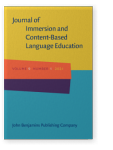Vol. 9:1 (2021) ► pp.58–84
Vol. 9:1 (2021) ► pp.58–84
Foreign language motivation in primary education students
The effects of additional CLIL and gender
This article explores the effects of the type of instruction (Content and language integrated learning, CLIL, vs. non-CLIL) and gender upon foreign language motivation in Primary Education learners in northern Spain. A total of 252 students with ages ranging from 9–12 completed a questionnaire measuring different motivation components. Results showed that CLIL students seem to manifest greater parental support and be more critical with their image as foreign language learners. Additionally, gender turned out to be a more influential factor in non-CLIL learning settings, since non-CLIL males obtained worse results than their female counterparts in overall motivation and intrinsic motivation. This gender effect was not observed in CLIL classrooms, which potentially makes this learning approach a more egalitarian educational setting for both genders in terms of foreign language motivation.
Article outline
- 1.Introduction
- 2.CLIL and motivation: A review
- 3.Research questions
- 4.Methodology
- 4.1Participants and context
- 4.2Instruments and procedure
- 5.Results
- 6.Discussion
- 7.Conclusions and suggestions for future research
- Acknowledgements
-
References
